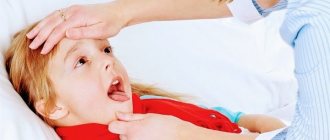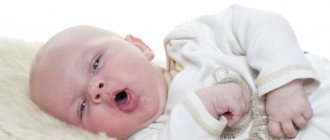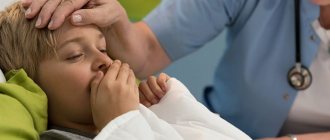A trip to the sea can not only be pleasant, but at some point it can also be overshadowed by the fact that the child has caught a cold . Children's immune system must be resistant to the usual effects of bacteria and microorganisms. A child, coming into this world, immediately acquires millions of different bacteria. Immediately after birth, his immune system is capable of mobilizing the body's defenses, which leads to natural resistance in children against colds and infectious diseases. The immunological activity of each child at different ages is individual. This is due to many factors, such as heredity, the mother-placenta-fetus relationship, the physiological maturity of the child at the time of birth, the nature of nutrition, and environmental influences. But a trip to the sea with a baby can distract the body from a normal, balanced life, then during the holiday you have a cough, runny nose , and maybe even worse - fever, sore throat, bronchitis, laryngitis .
The system of regulation of immunity in a child is complex and multi-stage. All chains of immunity - lymphocytes, phagocytes, humoral factors - function in close interaction and therefore a violation of one of them can lead to a deficiency of another. Contact of children with the world of microorganisms is inevitable, a strong immune system makes it possible to resist viral and microbial aggression, adapt to constantly changing external living conditions, but for example, acclimatization of a child can be somewhat painful when traveling to the sea - may become blocked and the temperature may even rise .
Acclimatization or a cold in a child at sea?
The essence of acclimatization comes down to adapting the body to new environmental conditions; the symptoms are similar to colds . But at the same time, she is very different from them. Therefore, the smaller the child , the more difficult it is for him to quickly adapt to new conditions. With small children, it is recommended to go from warm to warm, and from cold to cold for a reason, but so as not to injure the baby’s body too much.
Symptoms
- High temperature, usually on the second day of stay at sea;
- Lethargy, moodiness;
- Diarrhea and vomiting may occur due to changes in the quality of water and food;
- Cough and runny nose rarely appear, but can also occur during acclimatization. They do not require special treatment with medications, unless they are going to worsen to a sore throat or bronchitis . During adaptation, it is better to gargle and rinse your nose with sea water;
- Poor sleep and appetite.
At temperatures below 38.5 degrees, antipyretics should not be used.
Acclimatization problems
When choosing a place to stay at sea, remember that the smaller the difference in the climatic conditions of your region and the vacation spot, the better it will affect the child’s health, both during the vacation and after.
After arriving at the seaside, any child begins the acclimatization process, the duration of which depends on the age and general condition of the child.
The child's body, adapting to new conditions, can react in different ways. Manifestation of general weakness, headache, dizziness, sleep disturbance, and sometimes increased body temperature are typical signs of acclimatization. Sometimes a slight runny nose and cough can also appear as the body's reaction to new conditions. All these symptoms are often perceived by parents as colds that began on vacation. Don’t panic, let the child’s body get used to the new climate, let the child get a good night’s sleep, especially from the road, do not rush to bathe the child and actively warm him up in the sun, take a walk in the picturesque surroundings for a day or two. Use these days to have fun and develop your child. If the child is not sick, his condition will quickly improve.
You might be interested in the article - When can you bathe a child with a cough, and when not?
When starting water treatments, be interested in the water temperature. For babies, a comfortable temperature is considered to be more than 25 C. Remember that the younger the child, the worse his body thermoregulation is. Limit your time in the water to a reasonable amount, be sure to dry your child after each bath, and change your children’s swimming underwear. Blue lips and goose bumps are sure signs of hypothermia. Make sure your child does not sit on wet sand for a long time. When you get to your room, don’t forget that a cold in a child at sea (and in an adult as well) very often occurs as a result of severe hypothermia under air conditioning.
By following these simple rules, the likelihood that a cough will appear at sea is not high.
Results
Parents should provide proper care: protection and prevention of children during epidemics, especially if you are exposed to it while traveling at sea, proper nutrition, strengthening the immune system using a system of hardening methods, and a set of physical exercises. Frequently ill children should be taken to the sea every summer, because sea air and water will help strengthen the child’s body. But at the same time, it is important to take all precautions so that such prevention does not harm the body even more. Physical exercises and hardening procedures also have a beneficial effect on the growing child’s body. They increase reactivity and immunity, resistance to infectious and colds. Parents are required to know the rules for preventing infectious diseases and caring for a sick child, and to have an attentive and conscious attitude not only towards their own, but also towards other people’s children.
Photos and videos: free Internet sources
How to protect your child from colds at sea?
It is important to ensure that the child does not become overcooled when swimming and does not overheat in the sun. It is better to go to the beach during “safe hours” - before 11 am and after 16 pm
This will protect the body from the adverse effects of sunlight. At this time, it is better to relax, take a walk in a calm, not hot place. The head must be protected from direct exposure to sunlight. It is also important to ensure that the child is not in a draft, especially in transport.
The child should drink enough water and eat plenty of fruits and vegetables. You need to be careful when eating canned food, meat, and fish at sea. At high temperatures, there is a high probability of purchasing stale food. The risk of poisoning and food intoxication increases.
Coughing and bathing - benefits and harms
If a child has a cough and a runny nose, does not have a sore throat, does not have a fever, and the child is active, then this is usually a wet cough resulting from increased production of mucus in the nasal cavity, which flows down the back wall of the larynx. Salty sea water activates mucus secretion processes. There's nothing wrong with that. In this way, the respiratory tract is cleansed and healthy. In such cases, bathing a child with a runny nose is useful and necessary.
Swimming is also not prohibited if an allergic cough occurs. The fact that a child has an allergic cough will be indicated by additional symptoms such as excessive lacrimation, runny nose, increased irritability, and absence of fever. In such cases, the cough is non-productive. Taking antihistamines completely relieves an allergic attack.
Dry room air can cause an unproductive cough in the morning. Is it possible for a child to swim in the sea with a cough in such cases? Not only is it possible, but it is also necessary. Sea air has a beneficial effect on moistening the respiratory tract and quickly relieves this type of cough.
Cough in summer: causes and prevention
Many factors can cause the development of the disease:
- Drinking cold drinks and ice cream. People always try to drink cold juices and water in hot weather. Unfortunately, a sharp change in temperature in the upper respiratory tract can trigger the development of an inflammatory process, which can certainly lead to a cough in the summer.
- Air conditioners and fans in apartments, offices and cars. The circulation of cold, dry air dries out the nasal mucosa, which serves as a natural barrier to infections, and temperature changes negatively affect the body as a whole. Where people are constantly present, the temperature should be at least 22 °C. Ideally, the difference in degrees between the street and the room will be no more than 6-10 °C.
- Trips for recreation and visits. In summer, people move more actively, and with them microorganisms. There is a very high chance of contracting the virus on an airplane, train, or bus. Children are especially susceptible to this.
Is it necessary to bathe a child without fever, with a runny nose and cough?
Water procedures are among the hygienic measures aimed at improving skin respiration and gas exchange in tissues.
During the washing process, not only dust is washed off from the skin, but also sweat secretions, dead skin cells, sebum, etc. Regular bathing prevents the appearance of rashes on the body and also helps improve immunity.
Is it possible to bathe a child with a cough and runny nose without fever? According to experts, water procedures cannot harm the health of a small patient.
But immediately after taking a bath, the risk of hypothermia and, as a result, decreased immunity increases.
It is the decrease in the body's resistance, caused by overheating and hypothermia, that can provoke an exacerbation of cough and runny nose in a child. From the article you will learn in what situations you can resort to water procedures, and when it is better to refuse swimming.
Pediatricians' opinion
Before answering the question of whether it is possible to bathe babies with a cough and runny nose, you should understand what the symptoms are and why they appear.
Cough and runny nose are pathological manifestations that most often indicate inflammation of the upper and lower parts of the respiratory system.
To assess the likelihood of negative consequences after swimming, you need to take into account several important factors.
Cause of cough and runny nose
It should be understood that rhinitis and cough do not always appear with a cold. Unpleasant symptoms may be the result of an allergic reaction to complementary foods, medications, animal hair, washing powder, etc. In infants, cough syndrome often accompanies the process of teething.
During this period, the child’s salivation increases, which causes irritation of the cough receptors in the throat. In addition, cough and runny nose can be a consequence of the development of pathologies in the gastrointestinal tract, cardiovascular and endocrine systems.
Therefore, before washing your child, take him to the pediatrician and be sure to determine the reason for the deterioration in his health.
General condition of the child
If a small child, in addition to rhinitis and cough, exhibits other symptoms of a respiratory disease, it is better to refrain from water procedures for several days. Some of the most common signs of developing a cold in children include:
- headache;
- malaise;
- lack of appetite;
- increased sweating;
- chills.
Experts categorically do not recommend washing small patients during periods of exacerbation of infectious diseases. The slightest hypothermia can provoke the proliferation of pathogenic viruses and bacteria, which will subsequently lead to complications - bronchitis, tonsillitis, nasopharyngitis, etc.
Age
Infants are more likely to suffer from overheating and hypothermia, since their thermoregulation system does not work properly.
A sharp change in room temperature sometimes leads to local hypothermia of the ENT organs, which negatively affects local immunity.
If the cause of your baby’s cough and rhinitis is a cold, it is not recommended to perform water procedures in the first few days after the first signs of the disease appear.
Ignoring precautions in 6 out of 10 cases leads to the development of bronchitis, conjunctivitis and pneumonia.
Children over 2-3 years old can be washed, but only at the stage of resolution of inflammatory reactions in the respiratory tract. To prevent hypothermia, the water temperature should be several degrees higher than in the “pre-painful” period.
Washing and bathing are not the same thing
Very often, even after receiving valuable recommendations from a pediatrician regarding the treatment and care of a sick child, parents make mistakes. Few people know that there are fundamental differences between the concepts of “wash” and “bathe”. To clarify, let's look at the definitions of these terms in more detail:
“Wash” – remove dirt with liquid (water) in a short period of time. In other words, washing can be called a banal shower.
According to experts, children need to be washed in any condition, even during periods of exacerbation of ARVI.
The fact is that during a fever, along with sweat secretions, metabolites of pathogenic viruses and bacteria are removed from the body through the pores on the skin.
If you do not cleanse the skin of impurities in time, this will subsequently lead to the appearance of prickly heat, pimples and boils.
During periods of severe deterioration in the child’s well-being, it is recommended to wipe the body with a towel dipped in warm water. Alternatively, you can use hypoallergenic wet wipes.
“Bathing” is washing the body over a long period of time. Typically, bathing involves soaking your baby in a bath of warm water and splashing your baby for at least 10 to 15 minutes.
Swimming is recommended only if the small patient does not have fever or signs of hyperthermia.
In addition, after water procedures, it is necessary to create conditions that prevent hypothermia and deterioration of the baby’s well-being.
Precautionary measures
As soon as your child's temperature returns to normal, even if there is still a cough and rhinitis, allow him to take a shower or bathe. To prevent overheating or hypothermia, when performing water procedures, do not forget to follow several important rules:
- the water temperature should be 2-3 degrees higher than usual (the optimal temperature is 36-38 °C);
- before undressing the child, warm the bathroom to 25°C and eliminate drafts in the house;
- the time spent in the bath the first few times after an illness should not exceed 5-7 minutes;
- to speed up the separation of mucus from the mucous membranes of the bronchi and nasal passages, add steamed wild rosemary or eucalyptus leaves to the water;
- Immediately after water procedures, wipe the child’s body dry and dress him in warm, preferably flannel, clothes.
Important! After taking a shower or bath, you should not go outside for at least 2 hours, as this can lead to hypothermia.
During bathing in the bathroom, air humidity reaches 75-80%. According to practical observations, inhaling moist air only speeds up the healing process.
Water molecules condense on the inner surface of the nasopharynx, thereby reducing the viscosity of the mucus. Therefore, immediately after hygiene procedures, the baby’s runny nose or cough may worsen.
However, this does not indicate a deterioration in health, but rather the evacuation of sputum from the respiratory tract.
Bathing rules for various diseases
As already mentioned, cough can be a consequence of the development of several types of respiratory diseases at once. Therefore, before washing a small child, you need to make sure that there are no serious pathologies or disturbances in the functioning of the endocrine and cardiovascular systems. To prevent complications, during hygiene procedures you need to pay attention to the following rules:
Type of disease Characteristic symptoms Bathing rules
| ARVI | malaise headaches cough rhinitis | You can swim only 4-5 days after infection, the optimal water temperature is 36-37 °C, it is advisable to add essential oils of eucalyptus, pine needles and sea salt to the water |
| gastroesophageal reflux | morning cough, regurgitation of food, sore throat | washing is carried out as usual, it is recommended to add a decoction of medicinal chamomile to the water |
| bronchitis and tracheitis | wheezing when breathing, spasmodic cough, difficulty breathing | You can only shower and only for hygienic purposes |
| nasopharyngitis | barking cough sore throat severe runny nose decreased appetite | Swimming is allowed only during the recovery period; the duration of water procedures should not exceed 5 minutes |
| pneumonia | persistent cough difficulty breathing low-grade fever severe chest pain | at the stage of exacerbation of the disease, water procedures are replaced with wet rubdowns; swimming is possible only during the recovery period |
It is recommended to put your child to bed immediately after showering to prevent hypothermia. It is recommended to lubricate the feet and chest with warming ointment beforehand. However, it should be noted that the use of reflex drugs is allowed only if the child does not have a high fever.
Contraindications
Doctors emphasize the need for hygiene procedures, since children sweat a lot during illness.
Along with sweat, metabolites of infectious agents and drugs that need to be removed are removed from the body. Bathing prevents dehydration and promotes tissue oxygenation.
However, experts recommend refraining from carrying out hygiene measures in the following cases:
- period of acute respiratory viral infection (first 2-3 days);
- febrile fever (temperature over 38 °C);
- poor physical health (malaise, weakness, nausea).
In addition, it is not advisable to shower more than 3 times a week if you have a severe cough or runny nose. The slightest hypothermia will lead to relapse of inflammation and, as a result, re-development of infection in the respiratory tract.
Conclusion
Water procedures have a beneficial effect on the well-being of children, but they should be bathed during the period of resolution of inflammation in the respiratory tract. In the absence of fever, it is recommended to take a shower and bath at least 3-4 times a week. Hygiene procedures help cleanse the child's skin of dirt and sweat, which may contain toxins, bacteria and other substances.
To speed up the healing process, pediatricians advise adding decoctions of medicinal herbs – eucalyptus, wild rosemary, chamomile, nettle, etc. – to bathing water. They contain immunostimulating components that have a beneficial effect on tissue reactivity and stimulate healing of the mucous membrane in the nasopharynx.
Huseynova Irada
Sources: medscape.com, health.harvard.edu, medicalnewstoday.com.
Source: https://globalmedclub.ru/rinit/vydeleniya-i-pokashlivanie/mozhno-li-kupat-rebenka-pri-kashle-i-nasmorke.html
What to do if your child gets sick at sea
Your first action should be aimed at identifying the disease. The most common ailments associated with:
- Acclimatization;
- Infections;
- Colds that are caused by general hypothermia of the body;
- Complications after illnesses suffered before the vacation.
And if everything is more or less clear with the first point, then how can we understand the other options?
Mandatory consultation with a doctor is required if:
- The temperature stays above 38 degrees all the time and is difficult to bring down with antipyretics.
- The first signs of a sore throat are already beginning to manifest themselves: severe pain when swallowing, a red throat.
- Suspicion of otitis. His ears hurt, he stuffs them up and shoots at them.
- Unexplained rashes on the skin (this could be either a rotavirus infection or chickenpox).
- Vomiting and diarrhea that does not go away for a day. For infants, a maximum of 12 hours (be sure to ensure that the baby does not become severely dehydrated).
- If he has a dry mouth and has not urinated for 6 hours. This is a suspicion of severe dehydration.
We recommend that you stock up on rehydron (for dehydration), entrogel or activated carbon (for stomach problems) for your first aid kit. This is in addition to antipyretics and antihistamines.
IS IT POSSIBLE TO BATH A CHILD WITH A COLD, AND IF YES, HOW?
A cold means hypothermia of the body, which leads to a decrease in the body's immune defense. The result of a cold can be various inflammatory diseases and exacerbations of chronic diseases (for example, chronic rhinitis, sinusitis or bronchitis).
If your baby becomes hypothermic during a walk, starts sneezing and coughing after drinking cold water, or after running barefoot on a cold floor, the answer to the question of whether it is possible to bathe a child with a cold will be positive. Bathing should be avoided if the child has a fever or chills, the body temperature has risen above 38C, he is very weak, is capricious and has lost his appetite.
The most important thing when bathing is to prevent your baby from getting hypothermic. The water should be 1–2 degrees higher than usual, and the duration of water procedures should be reduced to 10–15 minutes
During this time, the child will warm up in warm water. After the bath, you should immediately wipe him dry and dress him in warm clothes or wrap him well. Then it is recommended to give a warm drink and put him to bed.
Do not forget about strengthening the immune system during a cold - if the body is weakened, Anaferon for children will help restore its protective function - a drug that has a mild immunomodulatory and antiviral effect.
Cough at sea in a child: possible causes, symptoms and treatment methods
Are you on vacation at the seaside and your child has a cough? This is a common situation, especially at the beginning of a vacation. It is a symptom of acute respiratory infections and sometimes of acclimatization.
During habituation, a cough serves as the body’s response to changes in air humidity; during a cold, it is a consequence of the penetration of a pathogen into the respiratory system.
Parents need to know how to distinguish them and what to do to prevent illness.
Where to go with your baby and what to consider?
For holidays with a small child, preference should be given to countries with a mild climate. These include resorts in Bulgaria or Romania, as well as the Black Sea coast. It is better to postpone vacations in Turkey and Egypt until later, when the baby reaches 2 years of age.
Healthy children tolerate a trip to the sea well. But parents should take into account that due to a sharp change in climate, the child may begin to acclimatize, the manifestations of which are similar to a cold. In contrast, addiction occurs without a strong dry or wet cough.
Acclimatization lasts, on average, 3-5 days, so there is no need to plan a short vacation with your child - it is better to go immediately for a month.
Acclimatization: symptoms and methods of control
Swimming in sea water and walking along the coast are good for your health. They help strengthen the immune system and reduce the incidence of respiratory diseases in the future. Water procedures in children evoke positive emotions, which is important at this age.
Acclimatization is difficult for children living far from the sea. Climate change can lead to a decrease in local immunity, so they often develop colds during vacation. At this time, the body becomes vulnerable to pathogens.
During acclimatization, the following symptoms may appear:
- congestion of the upper respiratory tract;
- watery nasal discharge;
- temperature up to 38 C.
- tearfulness, irritability;
- drowsiness;
- increased fatigue;
- constipation;
- loss of appetite.
Important! You should not force your child to eat - this will provoke vomiting.
A slight cough may appear after sleep. This is explained by the fact that nasal discharge accumulates in the nasopharynx when the child is sleeping and begins to move after a change in position, causing a cough.
Unlike a cold, acclimatization does not need to be treated; it will go away on its own in a few days. However, during this period, immunity decreases, so you should strengthen it before the trip.
To do this, take special vitamins.
There is no need to prescribe them yourself - your pediatrician will select a treatment regimen. If during acclimatization the child coughs a lot, it means that the process has been aggravated by a cold and treatment is needed.
Possible causes of a cold at sea
A child may get sick after water procedures in an open body of water in the first days of vacation. In this case, the cause of acute respiratory infections is hypothermia and weakened immunity. Therefore, you should not immediately get carried away with water procedures at first - it is better to wait 2-3 days. The sea water temperature should be above 25 degrees. You need to get used to it gradually.
The cause of feeling unwell with signs of a cold can be ARVI. In this case, viruses become the causative agents of the disease. A child’s body, unlike an adult’s, cannot resist them due to the lack of strong immunity.
Symptoms of the disease
The first manifestations of a cold occur within 1-2 days after infection. The greatest peak is reached on days 2-4 and persists for 7-10 days. Appear gradually, in increasing order:
- discomfort in the throat;
- nasal congestion;
- runny nose;
- sneezing;
- hoarseness, sensation of a foreign object in the nasopharynx;
- cough;
- low-grade fever.
The child loses his appetite and his sense of smell decreases. Due to nasal congestion, sleep is disturbed, vomiting and diarrhea may occur. After about 3-4 days from the onset of a cold, the mucus from the nose becomes thick, with inclusions of pus. But this does not mean that a bacterial infection has occurred.
Diagnostic methods
The symptoms of a cold are similar to those of other respiratory diseases, so at the initial stage it is necessary to distinguish it from them. For example, an allergic runny nose appears only after contact with an allergen and has a pronounced seasonality.
There is no hyperthermia or cough with him. The flu may cause snot, but its symptoms also include: joint pain, chills, temperature above 38.5 C. Bacterial infection of the upper respiratory tract begins with thick, profuse discharge from the nose.
First aid for a child and further treatment of a cold at sea
Decongestants are used to make breathing easier. Before using them, the nasal cavity is cleaned with saline or sea water solution. Let me blow my nose.
Important! Vasoconstrictor drugs are used as prescribed by a doctor - their use is not safe!
You should not lower your temperature if it is below 38.5 C - this is how the body fights the pathogen.
Immunomodulating and antiviral drugs and drinking plenty of fluids will help treat colds. Do not wrap your child up - this will lead to overheating of the body. If, along with an increase in temperature, a cough and sore throat appear, then local drugs are used. Inhalations with sea water will not be superfluous.
Is it possible to swim with a cough?
If a slight cough is not a manifestation of a cold or other disease, then water procedures at sea are not prohibited. You should focus on the child’s condition: if he is nauseous, has difficulty breathing and there is wheezing, then there is no need to get into the water - this is fraught with complications and infection.
If the cough is a residual phenomenon of ARVI/bronchitis/pneumonia, then you can safely swim in the sea and have fun. However, you should beware of hypothermia - a seemingly cured disease can return in an aggravated form.
Is it possible to go to the sea with a cough?
Sea air has a beneficial effect on the functioning of the respiratory tract. It is full of salt particles and moist. Walking on the coast speeds up the process of cleansing the body of mucus and dust.
Outdoor games, laughter and fun will train the muscles of the respiratory tract, which will contribute to recovery. Therefore, the answer to the question is clear - of course, it is possible, even necessary! But in this matter it is important not to overdo it - if the baby does not want to go anywhere, you should not insist.









